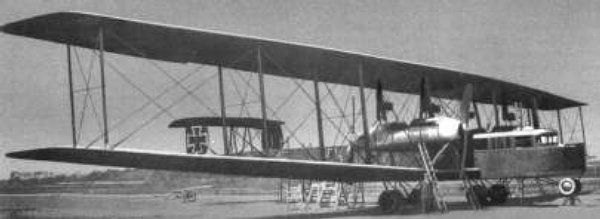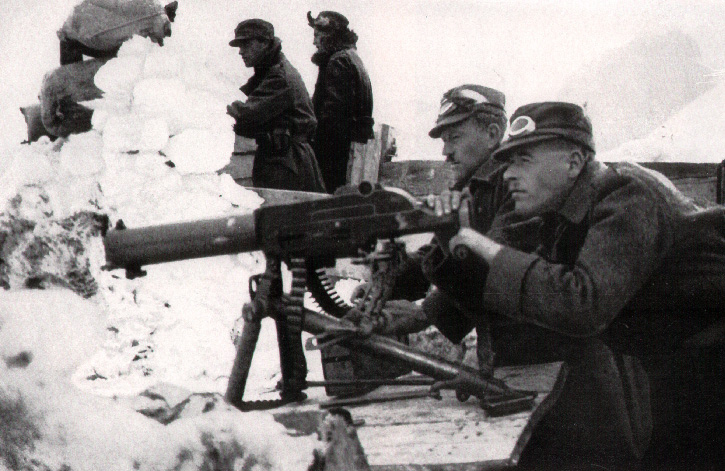|
Lloyd 40.08 Luftkreuzer
The Lloyd 40.08 Luftkreuzer (Sky Cruiser) was a three engine triplane bomber type built during World War I. The design was proven to be ineffective and development did not proceed past the prototype stage. Design and development In August 1915, the Austro-Hungarian Imperial and Royal Aviation Troops (''Luftfahrttruppen'') awarded funding to Lloyd for construction of a new heavy bomber that could carry a bomb-load and have endurance of at least 6 hours. The aircraft was to be powered by one powerful engine in a pusher configuration housed in a central nacelle and two smaller engines mounted in Twin-boom aircraft, twin booms on either side. In January 1916, Lloyd received specifications and drawings for a large triplane that was to be known as the ''Luftkreuzer''. The unequal Wingspan, span triplane had the middle wing mounted to the lower part of the main fuselage and booms, with the upper and lower wings supported by wire braced inter-plane struts. The centre section housed a ... [...More Info...] [...Related Items...] OR: [Wikipedia] [Google] [Baidu] |
WikiProject Aircraft
A WikiProject, or Wikiproject, is an affinity group for contributors with shared goals within the Wikimedia movement. WikiProjects are prevalent within the largest wiki, Wikipedia, and exist to varying degrees within Wikimedia project, sibling projects such as Wiktionary, Wikiquote, Wikidata, and Wikisource. They also exist in different languages, and translation of articles is a form of their collaboration. During the COVID-19 pandemic, CBS News noted the role of Wikipedia's WikiProject Medicine in maintaining the accuracy of articles related to the disease. Another WikiProject that has drawn attention is WikiProject Women Scientists, which was profiled by ''Smithsonian Magazine, Smithsonian'' for its efforts to improve coverage of women scientists which the profile noted had "helped increase the number of female scientists on Wikipedia from around 1,600 to over 5,000". On Wikipedia Some Wikipedia WikiProjects are substantial enough to engage in cooperative activities with outsi ... [...More Info...] [...Related Items...] OR: [Wikipedia] [Google] [Baidu] |
Lloyd C
Lloyd, Lloyd's, or Lloyds may refer to: People * Lloyd (name), a variation of the Welsh word ' ("grey") or ' ** List of people with given name Lloyd ** List of people with surname Lloyd * Lloyd (singer) (born 1986), American singer Places United States * Lloyd, Florida * Lloyd, Kentucky * Lloyd, Montana * Lloyd, New York * Lloyd, Ohio * Lloyds, Alabama * Lloyds, Maryland * Lloyds, Virginia Elsewhere * Lloydminster, or "Lloyd", straddling the provincial border between Alberta and Saskatchewan, Canada Companies and businesses Derived from Lloyd's Coffee House *Lloyd's Coffee House, a London meeting place for merchants and shipowners between about 1688 and 1774 * Lloyd's of London, a British insurance market ** ''Lloyd's of London'' (film), a 1936 film about the insurance market ** Lloyd's building, its headquarters ** Lloyd's Agency Network * ''Lloyd's List'', a website and 275-year-old daily newspaper on shipping and global trade ** ''Lloyd's List Intelligence'' (former ... [...More Info...] [...Related Items...] OR: [Wikipedia] [Google] [Baidu] |
1910s Austro-Hungarian Bomber Aircraft
Year 191 ( CXCI) was a common year starting on Friday of the Julian calendar. At the time, it was known as the Year of the Consulship of Apronianus and Bradua (or, less frequently, year 944 ''Ab urbe condita''). The denomination 191 for this year has been used since the early medieval period, when the Anno Domini calendar era became the prevalent method in Europe for naming years. Events By place Parthia * King Vologases IV of Parthia dies after a 44-year reign, and is succeeded by his son Vologases V. China * A coalition of Chinese warlords from the east of Hangu Pass launches a punitive campaign against the warlord Dong Zhuo, who seized control of the central government in 189, and held the figurehead Emperor Xian hostage. After suffering some defeats against the coalition forces, Dong Zhuo forcefully relocates the imperial capital from Luoyang to Chang'an. Before leaving, Dong Zhuo orders his troops to loot the tombs of the Han emperors, and then destroy Luoyang b ... [...More Info...] [...Related Items...] OR: [Wikipedia] [Google] [Baidu] |
Gotha G
''Gothaer Waggonfabrik'' (''Gotha'', GWF) was a German manufacturer of rolling stock established in the late nineteenth century at Gotha (town), Gotha. During the two world wars, the company expanded into aircraft building. World War I In World War I, Gotha was the manufacturer of a highly successful series of bombers based on a Gotha G.I, 1914 design by Oskar Ursinus and developed by Hans Burkhard. From 1917, the Burkhard-designed twin Pusher configuration, pusher biplane bomber aircraft were capable of carrying out strategic bombing missions over England, the first heavier-than-air aircraft used in this role. Several dozen of these bombers were built in a number of subtypes - the Ursinus-based Gotha G.I, and the succeeding Burkhard-designed Gotha G.II, G.II, Gotha G.III, G.III, Gotha G.IV, G.IV, and Gotha G.V, G.V. This last variant was the most prolific, with thirty-six in squadron service at one point. Inter war years Whilst Germany was prohibited from military aircraft ... [...More Info...] [...Related Items...] OR: [Wikipedia] [Google] [Baidu] |
Eger
Eger ( , ; ; also known by other #Names and etymology, alternative names) is the county seat of Heves County, and the second largest city in Northern Hungary (after Miskolc). A city with county rights, Eger is best known for Castle of Eger, its medieval castle, Turkish bath, thermal baths, baroque buildings, the northernmost Eger minaret, Ottoman minaret, and red wines. Its population of around 53,000 (2017) makes it the 19th largest centre of population in Hungary, according to the census. The town is located on the Eger Stream (a tributary of the Tisza river), on the hills between the Mátra and Bükk Mountains, Bükk mountains. The main campus of Eszterházy Károly Catholic University is in Eger. Names and etymology The origin of its name is unknown. One suggestion is that the place was named after the alder ( in Hungarian language, Hungarian) which grew so abundantly along the banks of the Eger Stream. This explanation seems to be correct because the name of the town ref ... [...More Info...] [...Related Items...] OR: [Wikipedia] [Google] [Baidu] |
Oberleutnant
(English: First Lieutenant) is a senior lieutenant Officer (armed forces), officer rank in the German (language), German-speaking armed forces of Germany (Bundeswehr), the Austrian Armed Forces, and the Swiss Armed Forces. In Austria, ''Oberleutnant'' is also a designation for certain positions in the federal police and prison guards. In the former West Germany, it was also a rank in the Federal Border Guard (''Bundesgrenzschutz''). Occupied Austria Germany In the German Army, it dates from the early 19th century. Translated as "first lieutenant", the rank is typically bestowed upon commissioned officers after five to six years of active-duty service. is used by both the German Army and the German Air Force. In the NATO military comparison system, a German is the equivalent of a first lieutenant in the Army/Air Forces of Allied nations. ;Other uses The equivalent naval rank is ''Oberleutnant zur See''. In Nazi Germany, within the SS, Sturmabteilung, SA and Waffen-SS, ... [...More Info...] [...Related Items...] OR: [Wikipedia] [Google] [Baidu] |
Zeppelin-Staaken R
Zeppelin-Staaken (sometimes ), was a German aircraft manufacturer originally named (Experimental Works Gotha-East (V.G.O.)) when it was formed in mid-1914 by Count Ferdinand von Zeppelin and Robert Bosch. The company rented facilities in Gotha with the objective to build large, long-range bomber aircraft. Alexander Baumann was hired by Zeppelin as the head designer. The company moved to the village of Staaken, near Berlin, in mid-1916 and was renamed , although it was commonly known as Zeppelin-Staaken.Haddow & Grosz, pp. 209–211, 230–231 Aircraft built * Zeppelin-Staaken L * Zeppelin-Staaken VGO.I * Zeppelin-Staaken VGO.II * Zeppelin-Staaken VGO.III * Zeppelin-Staaken R.IV * Zeppelin-Staaken R.V * Zeppelin-Staaken R.VI * Zeppelin-Staaken R.VII * Zeppelin-Staaken 8301 * Zeppelin-Staaken R.XIV * Zeppelin-Staaken R.XV * Zeppelin-Staaken R.XVI *Zeppelin-Staaken E-4/20 The Zeppelin-Staaken E-4/20 was a revolutionary four-engine all-metal passenger monoplane designed in 1 ... [...More Info...] [...Related Items...] OR: [Wikipedia] [Google] [Baidu] |
Nosed Over
Conventional landing gear, or tailwheel-type landing gear, is an aircraft undercarriage consisting of two main wheels forward of the center of gravity and a small wheel or skid to support the tail.Crane, Dale: ''Dictionary of Aeronautical Terms, third edition'', page 133. Aviation Supplies & Academics, 1997. From the Ground Up, 27th edition, page 11 The term taildragger is also used. The term "conventional" persists for historical reasons, but all modern jet aircraft and most modern propeller aircraft use tricycle gear. History In early aircraft, a tailskid made of metal or wood was used to support the tail on the ground. In most modern aircraft with conventional landing gear, a small articulated wheel assembly is attached to the rearmost part of the airframe in place of the skid. This wheel may be steered by the pilot through a connection to the rudder pedals, allowing the rudder and tailwheel to move together. Before aircraft commonly used tailwheels, many aircraft (like a ... [...More Info...] [...Related Items...] OR: [Wikipedia] [Google] [Baidu] |
Centre Of Gravity
In physics, the center of mass of a distribution of mass in space (sometimes referred to as the barycenter or balance point) is the unique point at any given time where the weighted relative position of the distributed mass sums to zero. For a rigid body containing its center of mass, this is the point to which a force may be applied to cause a linear acceleration without an angular acceleration. Calculations in mechanics are often simplified when formulated with respect to the center of mass. It is a hypothetical point where the entire mass of an object may be assumed to be concentrated to visualise its motion. In other words, the center of mass is the particle equivalent of a given object for application of Newton's laws of motion. In the case of a single rigid body, the center of mass is fixed in relation to the body, and if the body has uniform density, it will be located at the centroid. The center of mass may be located outside the physical body, as is sometimes the cas ... [...More Info...] [...Related Items...] OR: [Wikipedia] [Google] [Baidu] |
Schwarzlose M7/12 Machine Gun
The Maschinengewehr (Schwarzlose) M. 7, also known as the Schwarzlose MG, is a medium machine-gun, used as a standard issue firearm in the Austro-Hungarian Army throughout World War I. It was utilized by the Dutch, Greek and Hungarian armies during World War II. It was routinely issued to Italian colonial troops, alongside the Mannlicher M1895 rifle. The primary producers were the ŒWG in Steyr, and FÉG in Budapest. History In 1901 Schwarzlose designed a toggle-delayed pistol, but it went nowhere. However, in 1902 he applied for a patent on a toggle-delayed lock for a machine gun, and another one in 1903 for a belt feeding mechanism. Since he had only had the experience of designing handguns before, the design took several more years to finalize. The Schwarzlose M. 7 was a belt-fed machine gun, usually mounted on a tripod, designed by the Prussian firearms designer Andreas Schwarzlose. While its water-cooled barrel gave it an appearance broadly resembling the family o ... [...More Info...] [...Related Items...] OR: [Wikipedia] [Google] [Baidu] |






